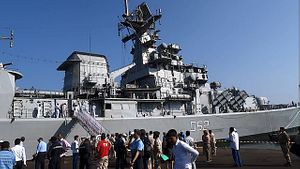As the Saudi Arabia-led military campaign–Operation Decisive Storm–continues against the Houthi rebels who have overrun large swathes of Yemen, several countries are evacuating their citizens from the country. For India, the evacuation effort represents a mammoth undertaking. Over the weekend, New Delhi carried out the largest aerial evacuation of any country in Yemen since hostilities began: it evacuated 670 Indian citizens on three Air India flights. Additionally, India’s Navy was sent to retrieve over a thousand Indian citizens. Overall, New Delhi has successfully rescued 2,300 of its own citizens so far.
India’s rescue efforts in Yemen, codenamed Operation Raahat, haven’t gone unnoticed. According to reports on April 6, 23 countries have requested Indian assistance in evacuating their citizens from Yemen. According to a tweet by Syed Akbaruddin, spokesperson for India’s Ministry of External Affairs, the list of countries comprises Bangladesh, Cuba, Czech Republic, Djibouti, Egypt, France, Germany, Hungary, Iraq, Indonesia, Ireland, Lebanon, Malaysia, Nepal, Philippines, Romania, Slovenia, Sri Lanka, Singapore, Sweden, Turkey, the United States, and Yemen.
Indian Prime Minister Narendra Modi, an active user of social media himself, expressed his support of India’s international rescue efforts: “I am also glad that India has rescued several non-Indian citizens from Yemen,” he remarked on Twitter. “Our evacuation efforts in Yemen reflect willingness to serve our people & readiness to help others in distress, which is India’s ethos,” he added. According to reports in the Indian press, Modi was in direct contact with Saudi Arabia’s King Salman after the initiation of Operation Decisive Storm. India had to negotiate extensively with Saudi Arabia to gain safe access for its aircraft to Yemeni airports for evacuation operations.
India has deployed a range of military and civilian assets to assist in its massive evacuation operation in Yemen. On the naval front, the INS Mumbai missile destroyer accompanied the INS Tarkash and INS Sumitra in evacuation operations. The Shipping Corporation of India additionally added two transport ships, the Kavaratti and the Coral, to the effort. In the air, in addition to the three Air India flights, the Indian Air Force deployed two of its C-17 Globemasters to aid in the evacuation effort.
India’s Yemen evacuation efforts are built on the government’s experience dealing with similar crises and evacuation efforts in the past. Indian citizens had to be evacuated last year from Iraq, after the Islamic State group overran Mosul and large swathes of northern Iraq. Additionally, India evacuated its citizens from Libya in 2011 and from Lebanon in 2006. Given the accessibility of the Gulf of Aden, the body of water off the southern coast of Yemen, from the Indian Ocean, it is perhaps unsurprising that India’s response has been swift and robust.
India’s response to the crisis in Yemen has been both competent and convincing when it comes to both the safety of its own citizens and collaborating with third parties. As I’ve written before, New Delhi is eager to build a reputation for itself as a reliable “first responder” in the Indian Ocean Region (IOR). Recently, before the current crisis in Yemen, India demonstrated this with its swift naval deployment to the Maldives after a water shortage crisis. By answering calls for assistance from nearly two dozen states in Yemen, India can prove that it’s up to the task.

































